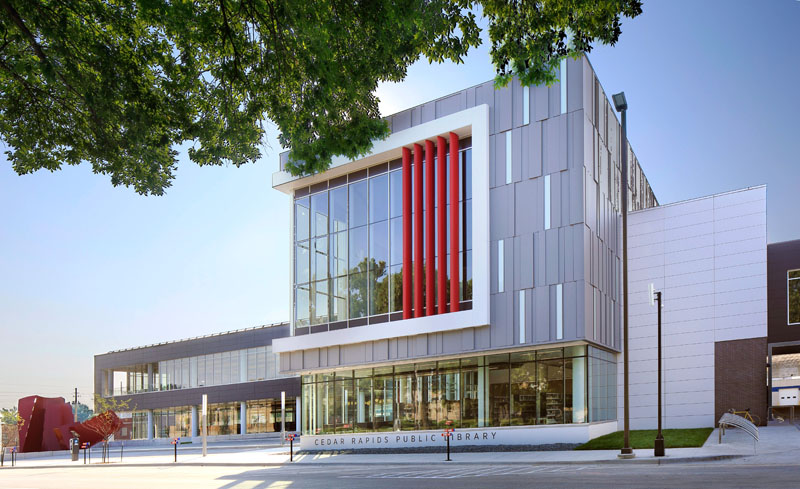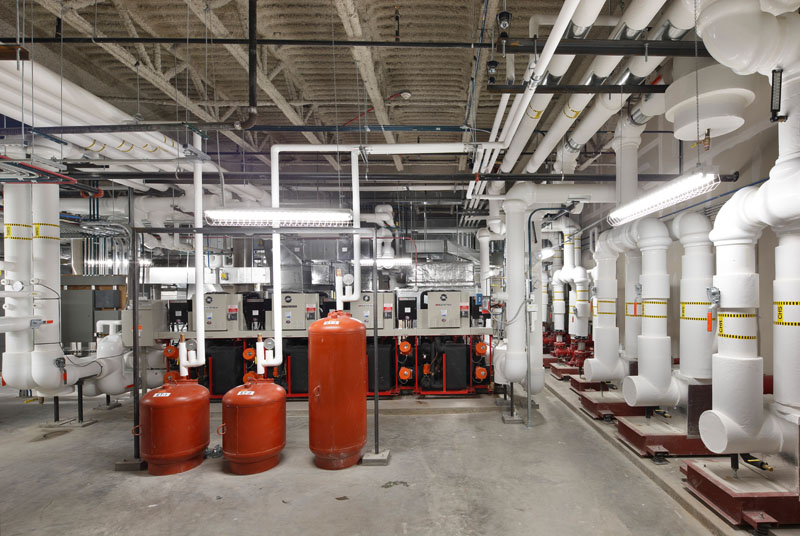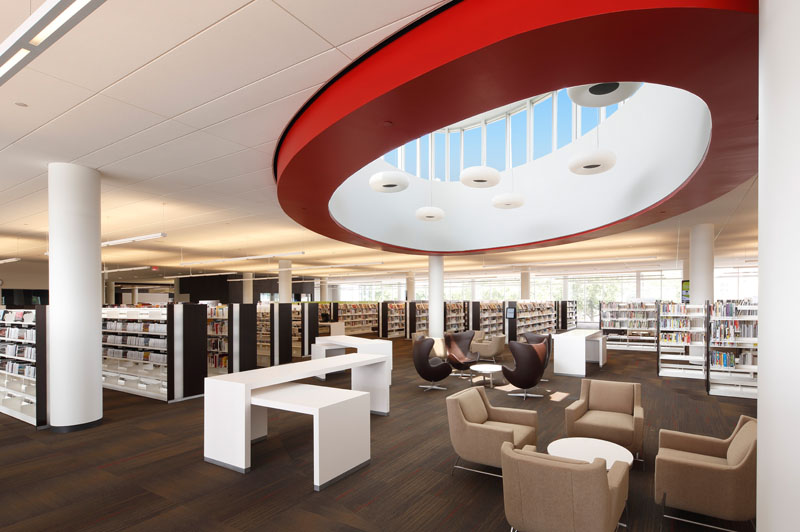Cedar Rapids Public Library
Cedar Rapids Public Library, Cedar Rapids, Iowa
The magnificent new 94,000 sq. ft main library in the heart of the City of Cedar Rapids replaces the library damaged in the 2008 flood. The project includes a 200-seat auditorium, offices, conference rooms, stack area, green roof, and a coffee shop.
 Goals of the project included:
Goals of the project included:
- LEED Platinum rating
- Improved accessibility
- Increased urban green space
- Exterior free of equipment
- Clear sightlines through the building.
The limited site for the project created a building with 3 prominent sides and minimal space to locate building utilities.
Sound Requirements
The library’s diverse usage required stringent sound requirements in some areas adjacent to areas with limited sound requirements. Sound attenuators, sound walls, and equipment placement were all utilized to accomplish low sound levels where required.
Heating & Cooling Design
 The building heating and cooling is supplied from a modular geothermal chiller/heater plant located in the third floor mechanical room connected to a pump and reinjection well system. To reach the LEED Platinum
The building heating and cooling is supplied from a modular geothermal chiller/heater plant located in the third floor mechanical room connected to a pump and reinjection well system. To reach the LEED Platinum
goal the building systems were designed at the highest efficiencies. The building site and project goals of a clean exterior limited the options for heating and cooling. The pump and injection system selected resulted in all mechanical equipment inside of the building while achieving the project efficiency goals.
The HVAC design includes multiple distribution system types meeting both occupant comfort and building construction constraints. Single zone displacement ventilation systems serve the 200-seat auditorium. The auditorium is a large open space with high ceilings and 3 exterior glass walls. To supplement the displacement ventilation along the glass the auditorium platform has a heated floor. The auditorium is the type of room ideally suited to displacement ventilation because this system supplies air at a low velocity which is very quiet and only conditions the occupied zone closest to the floor.
The second floor office and stack area utilize a 24” raised floor plenum for underfloor air distribution. This system allows for individual control for all occupants in these areas. The displacement and underfloor air distribution both reduce the amount volume that needs to be conditioned as well as reducing the outdoor air required for ventilation.
The first floor entry and stack area as well as the second floor conference rooms utilize conventional variable air volume with terminal reheat for space conditioning. The main entry is a two- story space with high amounts of infiltration so a radiant floor system was installed to supplement the heating. Perimeter heating, where required, was accomplished with fan-powered boxes with hot water coils below the floor. In utilizing underfloor air for the 2nd floor and ceiling distribution for the 1st floor all of the mechanical distribution for the stack areas was done between 1st and 2nd floor. This distribution created the desired exterior building elevations. Energy recovery units utilize enthalpy wheels to pretreat the required outdoor air for the building.
Green Roof System
The project goal of creating more green space along with the limited site resulted in the design of a 4,500 sq ft green roof plaza. The green roof is irrigated with captured rain water and building condensate which is collected into two 5,000 gallon storage tanks.
Electrical Design
 The electrical distribution system was designed to separate loads into unique panel boards for each the following categories: HVAC, lighting and receptacles. This was to facilitate measurement and verification of energy savings strategies. Multiple sub meters were installed to provide load information back to the building management system for tracking.
The electrical distribution system was designed to separate loads into unique panel boards for each the following categories: HVAC, lighting and receptacles. This was to facilitate measurement and verification of energy savings strategies. Multiple sub meters were installed to provide load information back to the building management system for tracking.
The service is a 277/480V, 3 Phase, 4 Wire system at 1200A. There is a 500kva step down transformer for the 1200A, 120/208V, 3 Phase, 4 wire, switchboard. Both switchboards are installed in the same room to allow efficient metering of all panel feeds. A 1200A kirk-keyed switchboard located in the loading dock area of the facility allows the temporary installation of a spot-use generator should the need arise.
Lighting Design and Controls
The lighting design for the library includes a mix of LED and fluorescent technologies. Specific color matching of sources was done to maintain a consistent performance throughout. However, color temperature was also changed in certain applications to allow features of the building to stand out. Unique lighting applications were designed around prominent features of the building, including cascading, interactive, LED panels on the wall at the main lobby stairs as well as on the exterior of the building.
 Lighting Controls in the main public spaces are controlled through a main lighting control panel, a Crestron PAC2M processor and GLX panel system that incorporate dimming modules and switching modules to effectively control light as needed. This panel has capabilities to trend usage of lighting circuits as well as interface with the BMS. In all areas where significant daylight is present, photo-controlled lighting through dimming ballasts is utilized. This includes on 1st floor, perimeter areas of the Children’s Library and Adult Fiction. On 2nd floor these areas are perimeter areas in Adult Non-Fiction, the Reading Room and the south wall of Business Admin.
Lighting Controls in the main public spaces are controlled through a main lighting control panel, a Crestron PAC2M processor and GLX panel system that incorporate dimming modules and switching modules to effectively control light as needed. This panel has capabilities to trend usage of lighting circuits as well as interface with the BMS. In all areas where significant daylight is present, photo-controlled lighting through dimming ballasts is utilized. This includes on 1st floor, perimeter areas of the Children’s Library and Adult Fiction. On 2nd floor these areas are perimeter areas in Adult Non-Fiction, the Reading Room and the south wall of Business Admin.
The large public spaces are controlled manually through master control stations located in staff-only areas and automatically for after-hours shutdown through an internal time clock in the panel.
The Large conference area on second floor will also be controlled through the main Crestron lighting control panel and manual wall controllers in the space. The Auditorium also has its own 48 circuit dimming panel with digital control through a DMX connection in the control booth and a single station wall controller near the panel. All other spaces have a mix of manual control for ON and occupancy sensor control for automatic OFF.
Download the Project Case Study: ![]() Cedar Rapids Public Library
Cedar Rapids Public Library


